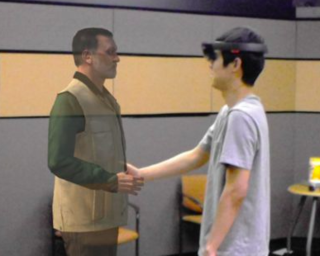Loneliness
The Metaverse Will Not Save You
Virtual reality tempts us to abandon the real in favor of the simulated.
Posted December 8, 2021 Reviewed by Ekua Hagan
Key points
- Facebook’s recent rebranding as Meta and its announcement about creating a "Metaverse" has sparked public interest, but it's nothing new.
- There will always be a difference between the feeling of being somewhere and knowing authentically that one is there.
- Recent interest in virtual reality and the Metaverse should be tempered by the preciousness of the real.

With Facebook’s recent rebranding as Meta, and its announcement of heavy investment in the creation of a metaverse, tech media have been abuzz with this word. Anyone who watched (possibly with some amusement) the recent video showing Mark Zuckerberg, CEO of Meta, extolling the virtues of this new virtual realm, might suspect that there’s more smoke than there is fire here. Meta’s own description of their metaverse as “…a set of virtual spaces where you can create and explore with other people who aren’t in the same physical space as you” is nothing new.* After all, games like Fortnite have been around for quite a while now. What Meta is suggesting is that thanks to a nifty redesigned virtual reality (VR) headset and an online platform that they will provide, we will want to use the magic “presence” of VR for more of our everyday life. Presence is a term long-used by virtual reality researchers to refer to the feeling of being “there,” where “there” is somewhere other than one’s physical location (Berkman & Akan, 2019). If I wear a headset that makes me feel as though I’m standing on a highwire over Niagara Falls, presence will mean that I feel the same kinds of psychological effects as if I was teetering over the Falls themselves.
Why now?
Even by the basic definition of a metaverse offered by Facebook, it’s easy to see the possibilities for education, research, and entertainment. But many of us have also been disappointed by this technology time after time. There have been repeated cycles of hype followed by painful collapses for these kinds of tools ever since their beginnings in the 1960s. Mostly, we’ve blamed the shortcomings on the tools—computers that ran too slowly or optics that provided minuscule low-resolution windows into virtual worlds. Now that some of those barriers are falling and a decent home VR setup is available for less than the price of a good television, things may change.
But the timing of this is interesting. We are beginning to emerge from a long pandemic during which, for many reasons, we’ve suffered enormous anxiety and depression. Some of that malaise has come from painful physical separation from one another. The spaces we inhabit have been fractured into sad, lonely places. Would this all have been so much better if we had been able to vault into hyperspaces to gather around virtual firepits or whiteboards?
At the risk of sounding old-fashioned, the same kinds of issues that have made our networked existence so alienating and lonely (cringey family Zoom calls, taxing online work meetings) may not be improved much by wearing a helmet and experiencing virtual presence with others. Even with further refinements of the technology and even if we were able to produce something as convincing as a Star Trek Holodeck, these simulated experiences would still be permeated by a metaphysical absence. Present or not, there will always be a difference between feeling as though we are somewhere and knowing authentically that we are there. I’ll explore those differences in a later post.
Despite my skepticism about how big a role VR will play in everyday life and how much time we might want to spend in the kind of metaverse styled by Meta, I’m curious about the juxtaposition of these developments and the seismic existential come-uppance that we’ve all just experienced because of the pandemic. Thinking about these fantasies of life in an alternate universe, I had an unexpected clang association with the phrase “Be Here Now,” popularized by the 1960s prophet and hallucinaut Ram Dass, who published a bestselling manual for hippies with that title. The social upheavals of that era were powered by a generation fed up with the dark machinations of the military-industrial complex, environmental degradation and capitalism without conscience. Sound familiar? The hippie movement represented an abdication or “checking out” of the power matrix of society, the “establishment.” Dass urged us to respond to the sicknesses of the world by retreating into something smaller, immediate, manageable: the present moment.
Digital déja vu all over again
Maybe it’s nothing more than a fever-dream, but I see both parallels and inversions in the current Meta-buzz. The parallels have to do with a young generation frustrated by a world full of wicked problems—unabated climate catastrophes, social and economic inequities that are not gaps but chasms, political turmoil both domestic and global. Who wants to Be Here Now when maybe, just maybe, we can Be There Now? Like characters in Ready Player One, there may be an attraction to the idea of being able to put on a piece of high-tech sensory armor that can block out the squalid real and replace it with a shiny new metaverse.
But here’s the odd inversion: The leaders of the march to the Metaverse are not visionary mavericks standing up to The Man. They are The Man! Any company whose business model consists of measuring and predicting human behavior for commercial gain profits massively from an interface that effectively swallows us up and puts us inside a digital universe. What is more subtle is that a part of the pitch invites us to devalue everything that lives outside the helmet. My guess is that, ultimately, we won’t buy it. We live in strange times where technology invites us to juggle remarkable new versions of everyday reality. As challenging as it will be to do so, it is critical that we evaluate the virtual realities on offer and their psychological impact on our ability to live with one another as authentic, embodied human beings in a rich and diverse physical world rather than as one-dimensional caricatures of ourselves in the virtual realm. It’s up to us to try to understand both what might be gained and what is lost by the abandonment of the real in favour of a digitally simulated metaverse.
* Full disclosure: There’s a lot more to the term “metaverse” than implied by the Meta definition. If you haven’t heard of NFTs, blockchain, and cryptocurrencies, their "metaversical" connections are worth exploring.
References
Berkman, J.I. & Akan, E. (2019). Presence and Immersion in Virtual Reality. In: Lee N. (eds) Encyclopedia of Computer Graphics and Games. Springer, Cham.


